Ahead of the Tarnanthi Art Fair, we spoke with artist Karen Napaljarri Barnes, Tarnanthi's artistic director Nici Cumpston, and three Tarnanthi art fair buyers about what to consider when purchasing Aboriginal art.
How to buy Aboriginal art
Tarnanthi means to come forth or appear – like the sun and the first emergence of light, or a seed sprouting. It is a Kaurna word and the name of the nation’s largest survey of contemporary Aboriginal artists. Tarnanthi Art Fair
Tandanya, 253 Grenfell Street, Adelaide 5000
5-8pm Fri, 18 October 2019
10am-4pm Sat, 19 October 2019
10am-4pm Sun, 20 Oct 2019
Tarnanthi takes place each year in Adelaide. This year 1,000 artists are being represented in Tarnanthi and one of the hallmarks of the festival is the art fair that takes place on opening weekend at Tandanya.
We go inside the homes of three very happy art buyers to talk about their unique experiences at the fair and the transformation original art brings to a home.
Everything you wanted to know about buying Aboriginal art but were too afraid to ask
A Q&A with Tarnanthi artistic director, Nici Cumpston

CM: What forms of art will I find at an Aboriginal art fair?
NC: Works of art are unique and diverse, as are the artists who produce them, so you can expect to find unexpected treasures. At Tarnanthi Art Fair, paintings range from works on canvas and linen by artists who have used natural earth pigments or acrylic paint and ink, to soft-sculptures and wearable art. You will find a range of hand-made and unique works of art, as well as manufactured products that are ethically licensed to individual artists.
Do you have any tips on how to choose and buy a work of art?
Take the time to look at the works closely and ask yourself what it is that you like about it. Once you have found a work that you are interested in, ask the stallholder if there is a particular story behind it, ask who the artist is and try to find out a bit more about them. This will give you a broader insight to the artist and the work of art.
How do I know if I am purchasing works ethically and that artists are being paid properly?
The Tarnanthi Art Fair is an ethical marketplace to buy works of art directly from artists, so you can be sure the artists are being paid properly for their works. This is also why it is important to respect the retail price on works of art.
Is it wrong to mount a functional object – like a bowl – on my wall if that’s not the context it was made for?
Sculptural works including baskets can be displayed on the wall – three dimensional objects included amongst two dimensional can make for very interesting displays in your home. There are some incredible designs being produced on textiles at art centres across the country. Think broadly about how you can use them: they can be made into curtains, cushion covers, quilts or even stretched and hung as a painting.
Amy Joy Watson
Visual artist, sculptor
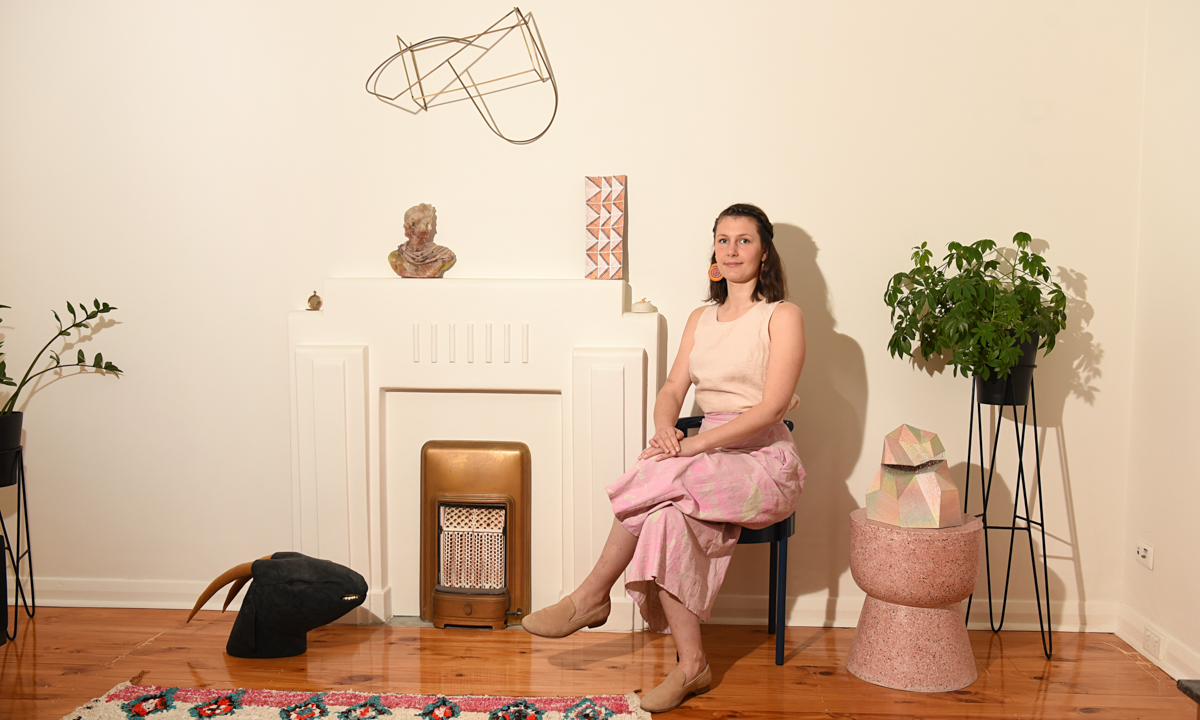
Amy was at the first ever Tarnanthi Art Fair and the small bark painting on the mantelpiece is her proof.
Purchased amid a throng of people, Amy recalls the incredible new feeling of viewing art, stacked in piles and surrounded by hundreds of people.
“When I take my work to Hugo Michell they’re putting on white gloves and handling it with care,” says Amy.
“When it’s on a wall in a gallery, you don’t touch it. Then at the art fair you can be literally flicking through these artworks like records at a record store. It’s really lovely, but at the same time you have that feeling, ‘Am I allowed to do this?’”
More than handle the art, you can wear it too. Amy purchased fabric at a subsequent Tarnanthi Art Fair that she had made into the trousers she’s wearing in this picture.
“I had them tailored based on another pair of pants I love,” says Amy. “I thought it might have been sacrilege to cut up this beautiful fabric, but the ladies at the stall said ‘No’ and showed me photos of all the different clothes people had made their textiles into.”
Nadia Rossi
Co-founder of isthisyours? theatre company
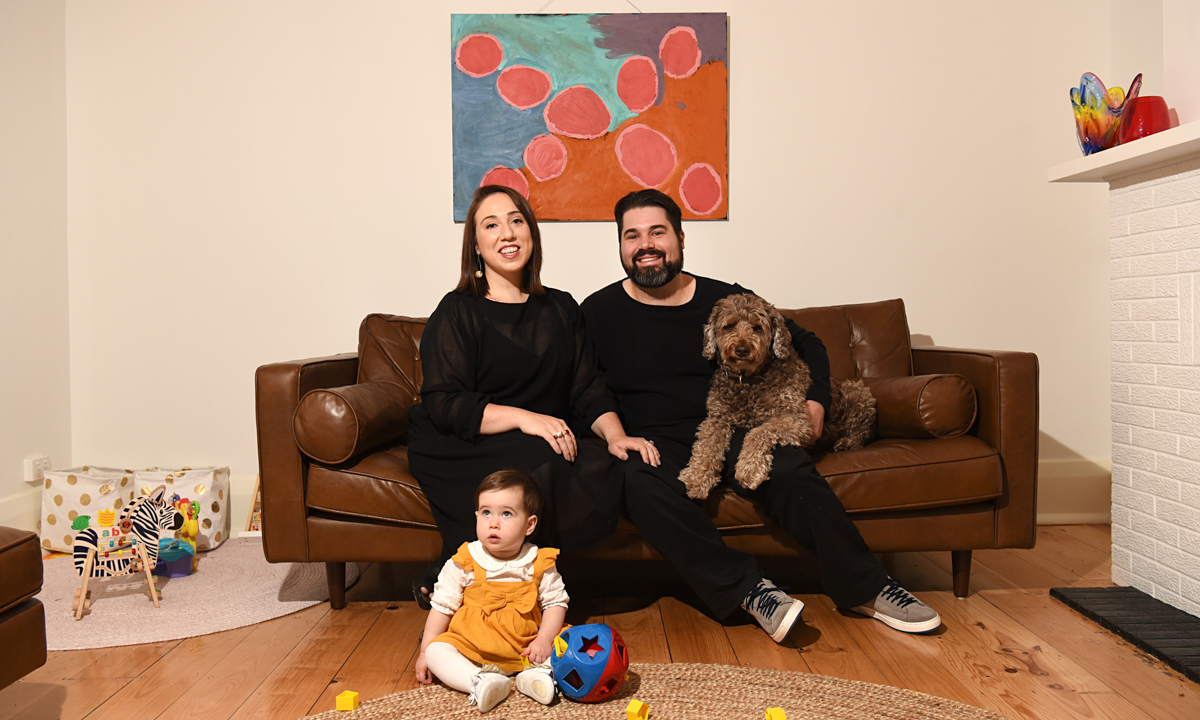
Nadia went to her first Tarnanthi Art Fair with quite a traditional idea of what Aboriginal art was and the kind of artwork she was looking to buy.
“There’s a particular women’s ceremony, which is done in black and white and so I went with that in mind and then I got to the fair and found Doreen Chapman,” says Nadia.
Doreen paints for a couple of studios but Nadia says it was Spinifex Hill Studio who were representing her at that particular fair. The memory of the art fair is present in Nadia’s mind’s eye as she recalls the visceral experience, holding several paintings in her hands at once and being pestered by other art buyers about whether she was going to buy what was in her hands or not.
“Intense,” is how Nadia describes it, in the most wide-eyed and favourable meaning of the word.
Nadia’s husband Karl Glaser notes that the work first hung in the hallway when it came home, but now hangs in the living room.
“It was a display piece, but now it’s moved to more of a home piece here,” says Karl. Nadia agrees.
“I loved that it was a place that represented Doreen’s home and I’d just had Angelina (pictured, on the rug) and I was very much in that nesting home vibe and I loved that it could be a part of our home,” says Nadia.
Since the purchase though, the artwork has become more sentimental than exciting, and the move from the hallway to the family room gives the work more meaning.
“This is where we spend most of our time and it feels very much like home and it’s such a part of our lives. I think having all those personal artworks it makes your home feel like a home.”
Ella Walker
Founder, creative director of Etikette Candles
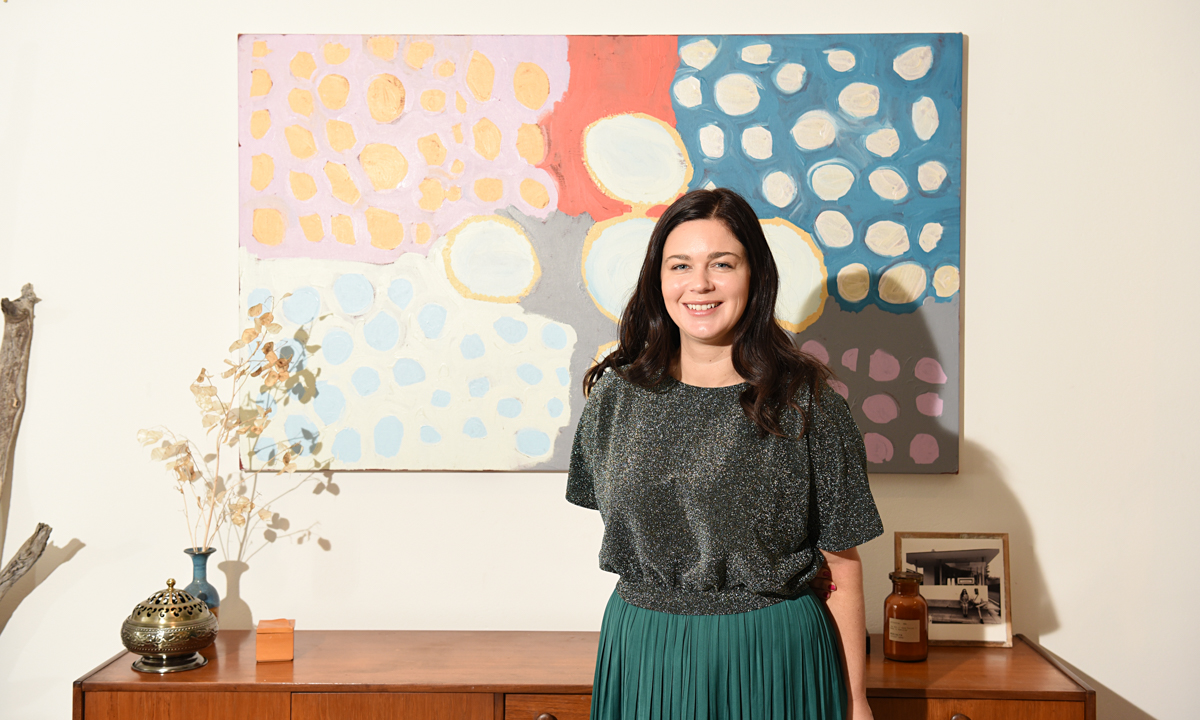
On top of Mount Lofty, hemmed in by fog on all sides, the home of Ella Walker opens up warmly to us when husband Matt Phillips greets CityMag at the door.
Tasteful artworks dot the walls and shelves, complemented by beautiful pieces of furniture throughout. Tea is offered and accepted as we spy the Doreen Chapman on the wall above Ella and Matt’s sideboard.
“It was really overwhelming – in an amazing way,” says Ella.
“I didn’t know what to expect. I’d never been to an art fair before, so walking into the space – the actual energy is amazing. In that moment when you’ve fallen in love with something, for whatever aesthetic or emotional reason, but you’ve got this fear that someone else will like it and take it before you get it, adding to the whole experience.”
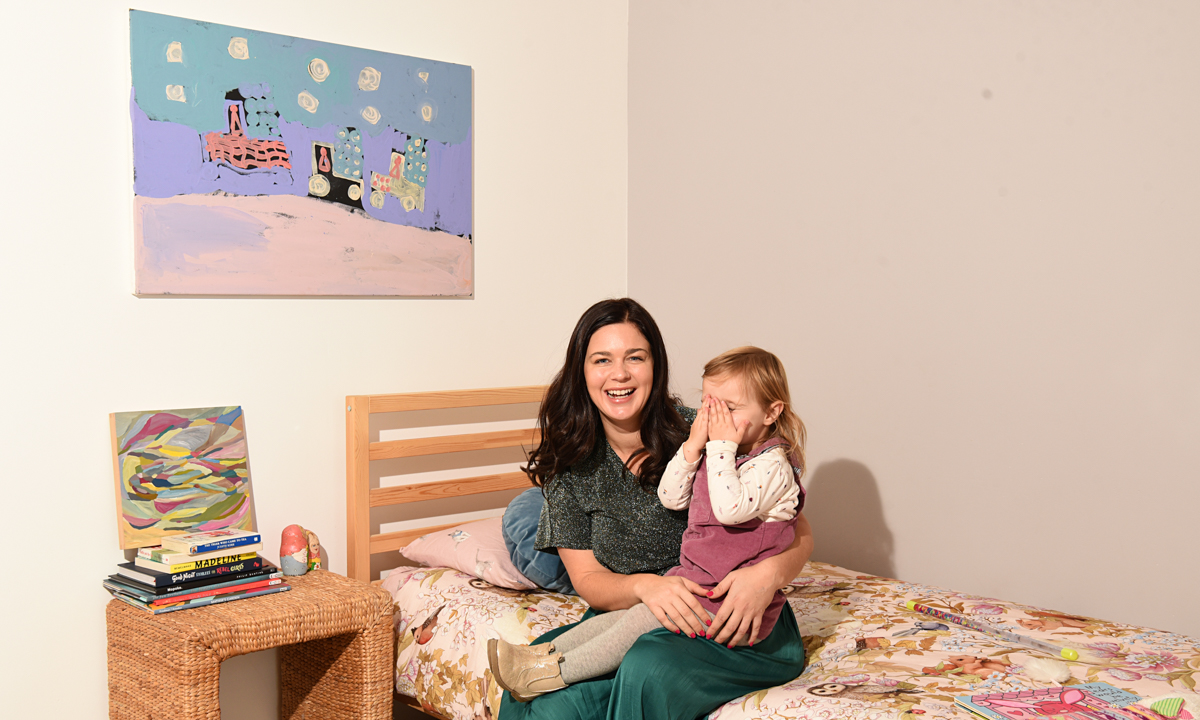
Ella ended up coming home with three pieces, one of which hangs in her daughter Rumi’s room.
“That’s her storytelling of her going camping – three trucks with swags piled up in the back,” says Ella.
“And I love how literal this one is and how we can have it in here for Rumi and we can talk to her about adventuring and storytelling – while the other piece is so abstract and also challenges the traditional concepts of Aboriginal art.”
Matt loves what Ella bought, but is making sure he gets to go to the fair this year as he missed out last time.
Q&A with artist Karen Napaljarri Barnes
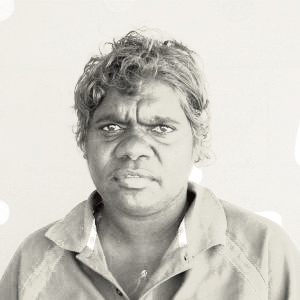
CM: How do you feel about your works of art being purchased and re-housed in homes across the country?
KNB: It makes me happy to paint the birds, the animals around me. I feel proud that my work makes other people smile. People tell me all the time that my work makes them happy. It is a good feeling.
What’s your experience of Tarnanthi?
I love going to the big city. It’s good to meet other artists and to see their paintings, too. I am very proud to be included in the art fair. I learnt to paint from my grandmother, Judy Watson, who was a number one artist. Now it is my turn to show my work.
What do you love to paint most?
I love painting kissing animals. I went to Uluru this year and I saw camels and emus and kangaroos and I loved seeing the rock, too. I painted all these things.
warlu.com/artist/karen-napaljarri-barnes/




